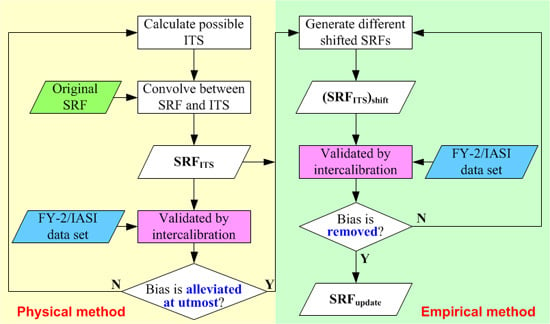In-Orbit Spectral Response Function Correction and Its Impact on Operational Calibration for the Long-Wave Split-Window Infrared Band (12.0 ?m) of FY-2G Satellite
Abstract
:1. Introduction
2. Methods
2.1. Cold Biases of the FY-2G IR2 Band and Its Root Cause Analysis
2.1.1. Cold Biases of FY-2G IR2 Band During Its Early In-Orbit Situation
2.1.2. Analysis of Cold Bias for the FY-2G IR2 Band and Identification of Its Root Cause
2.2. A Novel Approach Combining Both Physical and Empirical Methods for In-Orbit SRF Correction
2.3. Impact of the SRF Correction on the Operational IBBC Approach
3. Results
3.1. Results of the Physical Method under Some Limited Conditions
3.2. Results of the Empirical Method for an Optimal SRF-Shift Estimation
3.3. Long-Term Monthly Biases of FY-2G IR2 Band Monitored under GSICS
4. Discussion
5. Conclusions
Acknowledgments
Author Contributions
Conflicts of Interest
References
- Goldberg, M.; Ohring, G.; Butler, J.; Cao, C.; Datla, R.; Doelling, D.; Gartner, V.; Hewison, T.; Iacovazzi, B.; Kim, D.; et al. The global space-based inter-calibration system. Bull. Am. Meteorol. Soc. 2011, 92, 467–475. [Google Scholar] [CrossRef]
- Cao, C.; Goldberg, M.; Wang, L. Spectral bias estimation of historical HIRS using IASI observations for improved fundamental climate data records. J. Atmos. Ocean. Technol. 2009, 26, 1378–1387. [Google Scholar] [CrossRef]
- Sohn, B.J.; Kim, B.R.; Lee, S.S. Possible shift of spectral response function of the MODIS 6.8 μm water vapor channel causing a cold bias up to 3 K. Atmos. Meas. Tech. 2010, 3, 1667–1672. [Google Scholar] [CrossRef]
- Hewison, T.J.; Müller, J. Ice Contamination of Meteosat/SEVIRI Implied by Intercalibration against Metop/IASI. IEEE Trans. Geosci. Remote Sens. 2013, 51, 1182–1186. [Google Scholar] [CrossRef]
- Wu, X.; Yu, F. Correction for GOES Imager Spectral Response Function Using GSICS. Part I: Theory. IEEE Trans. Geosci. Remote Sens. 2013, 51, 1215–1223. [Google Scholar] [CrossRef]
- Yu, F.; Wu, X. Correction for GOES Imager Spectral Response Function Using GSICS. Part II: Applications. IEEE Trans. Geosci. Remote Sens. 2013, 51, 1200–1214. [Google Scholar] [CrossRef]
- Wang, L.; Wu, X.; Weng, F.; Goldberg, M.D. Effects on Ice Decontamination on GOES-12 Imager Calibration. IEEE Trans. Geosci. Remote Sens. 2013, 51, 1224–1230. [Google Scholar] [CrossRef]
- Guo, Q.; Chen, F.; Chen, B.; Feng, X.; Yang, C.; Wang, X.; Zhang, Z. Internal-blackbody calibration (IBBC) approach and its operational application in FY-2 meteorological satellites. Quart. J. R. Meteorol. Soc. 2016, 142, 3082–3096. [Google Scholar] [CrossRef]
- Hewison, T.J. An Evaluation of the Uncertainty of the GSICSSEVIRI-IASI Intercalibration Products. IEEE Trans. Geosci. Remote Sens. 2013, 51, 1171–1181. [Google Scholar] [CrossRef]
- Norton, P. HgCdTe Infrared Detectors. Opto-Electron. Rev. 2002, 10, 159–174. [Google Scholar]
- Weinreb, M.P.; Jamieson, M.; Fulton, N.; Chen, Y.; Johnson, J.X.; Smith, C.; Bremer, J.; Baucom, J. Operational calibration of GOES-8 and -9Imagers and Sounders. Appl. Opt. 1997, 36, 6895–6904. [Google Scholar] [CrossRef] [PubMed]
- Van de Berg, L.; Heinemann, T.; Szyndel, M.; von Bremen, L.; König, M.; Rogers, C.; Pili, P.; Yildrim, A. The Calibration of the infrared channels of Meteosat first and second generation spacecraft. In Proceedings of the EUMETSAT Meteorological Satellite Conference, Weimar, Germany, 29 September–3 October 2003. [Google Scholar]
- Spectral Response Functions. Available online: https://www.star.nesdis.noaa.gov/smcd/GCC/instrInfo-srf.php (accessed on 6 June 2017).
- Guo, Q.; Pei, Y.; Lan, Z. Study of H2O Contamination on a Cooled Optical Surface. J. Infrared Millimeter Waves 1995, 14, 132–138. [Google Scholar]
- Stamnes, K.; Tsay, S.; Wiscombe, W.; Jayaweera, K. Numerically stable algorithm for discrete-ordinate-method radiative transfer in multiple scattering and emitting layered media. Appl. Opt. 1988, 27, 2502–2509. [Google Scholar] [CrossRef] [PubMed]
- Gardner, A.S.; Sharp, M.J. A review of snow and ice albedo and the development of a new physically based broadband albedo parameterization. J. Geophys. Res. 2010, 115, F01009. [Google Scholar] [CrossRef]
- Warren, S.G.; Brandt, R.E. Optical constants of ice from the ultraviolet to the microwave: A revised compilation. J. Geophys. Res. 2008, 113, D14220. [Google Scholar] [CrossRef]
- Notice about Update of SRF for FY-2G Infrared Channel 2. Available online: http://www.nsmc.org.cn/en/NSMC/Contents/100157.html (accessed on 6 June 2017).
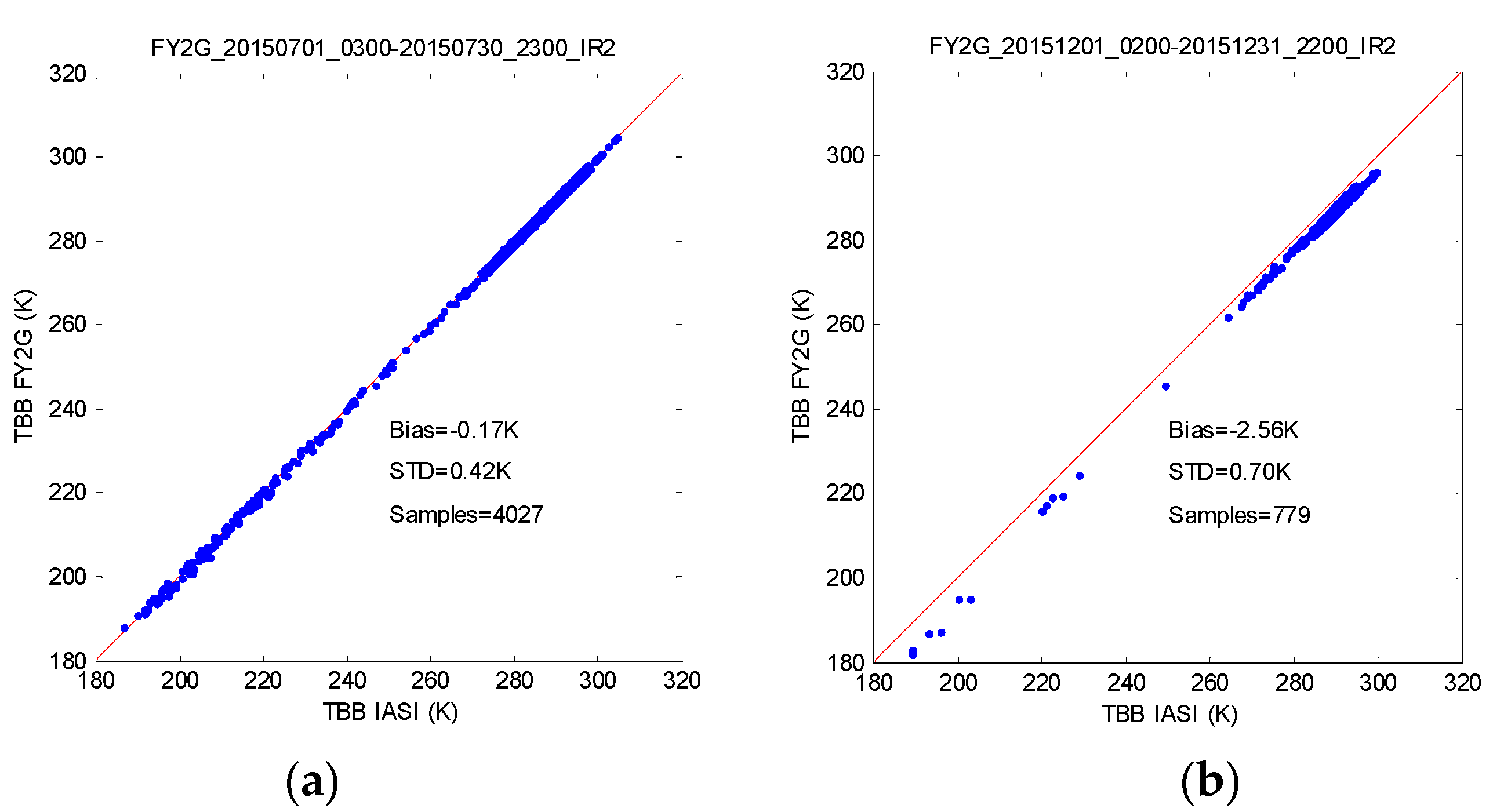
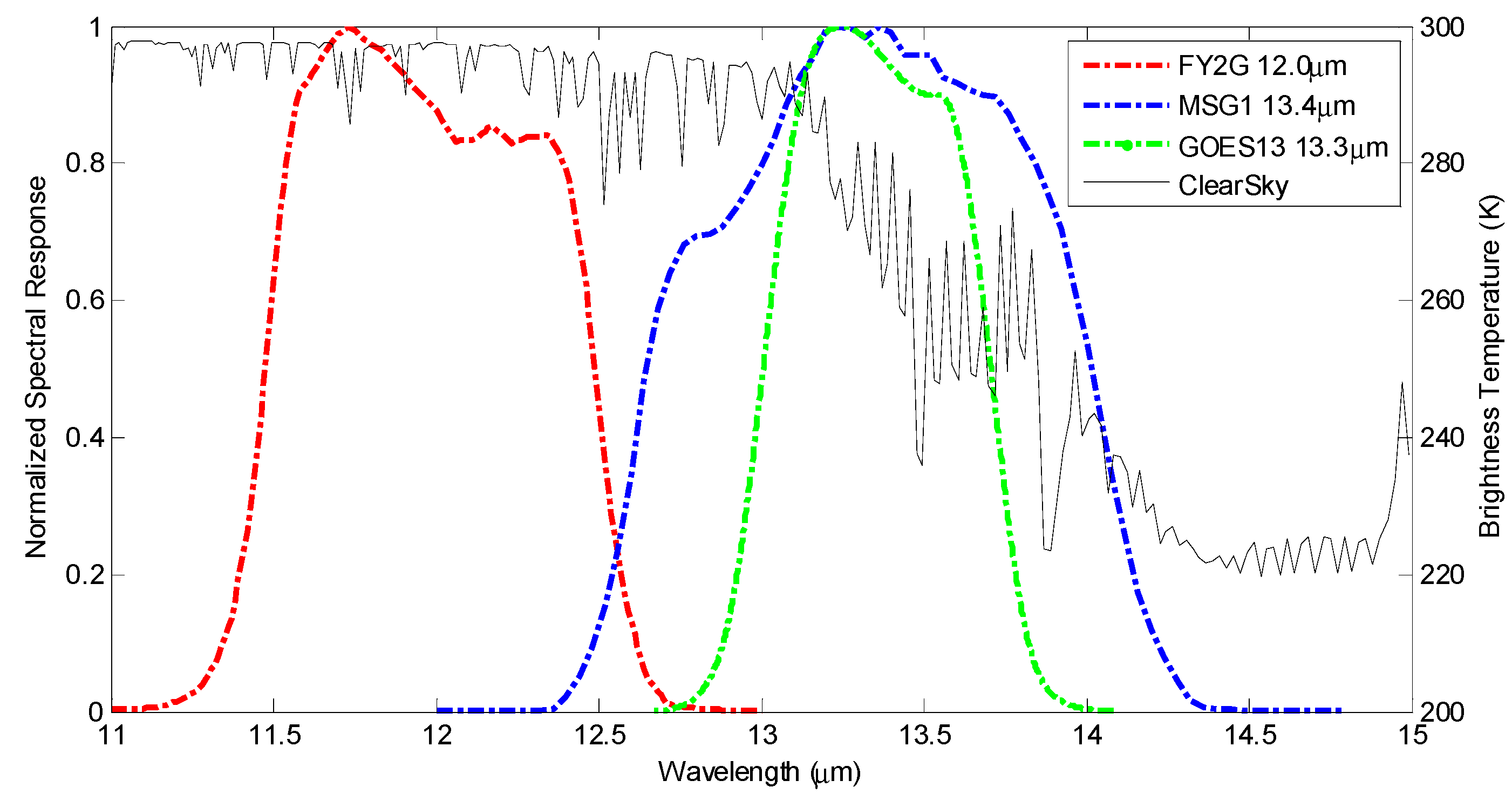
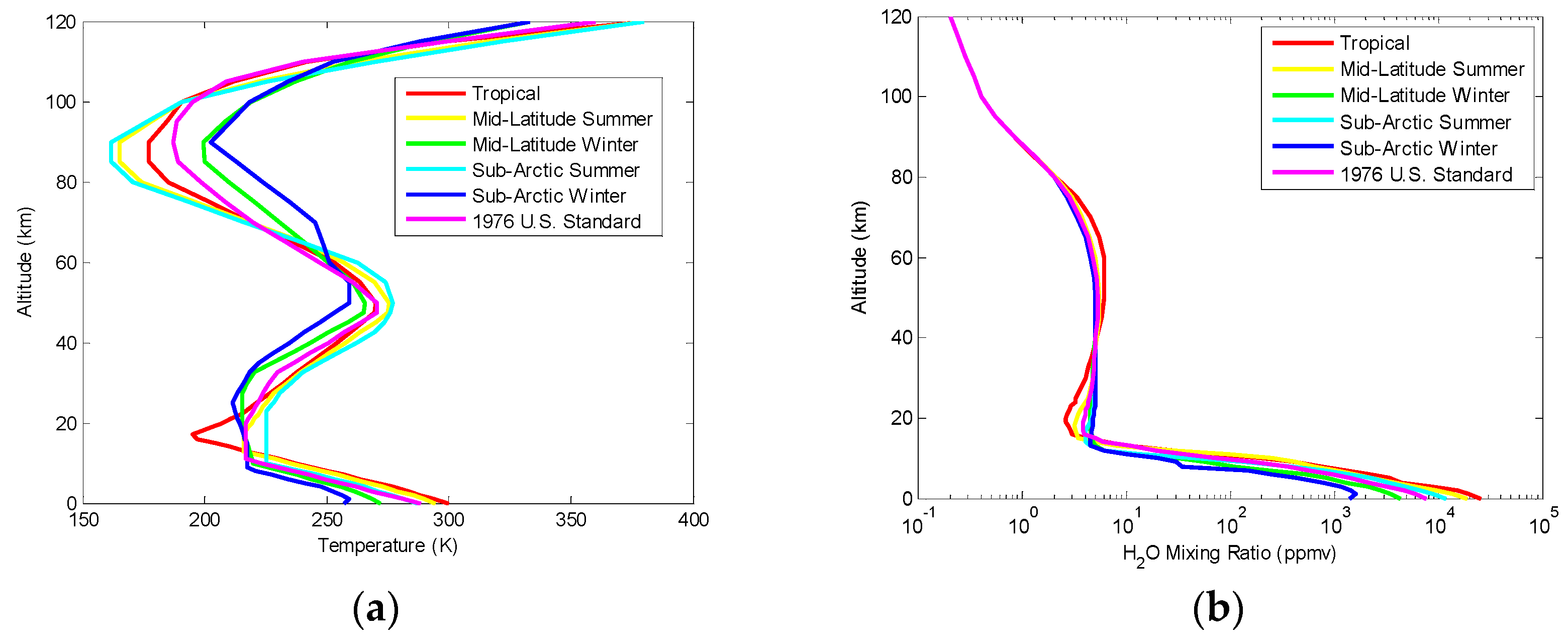
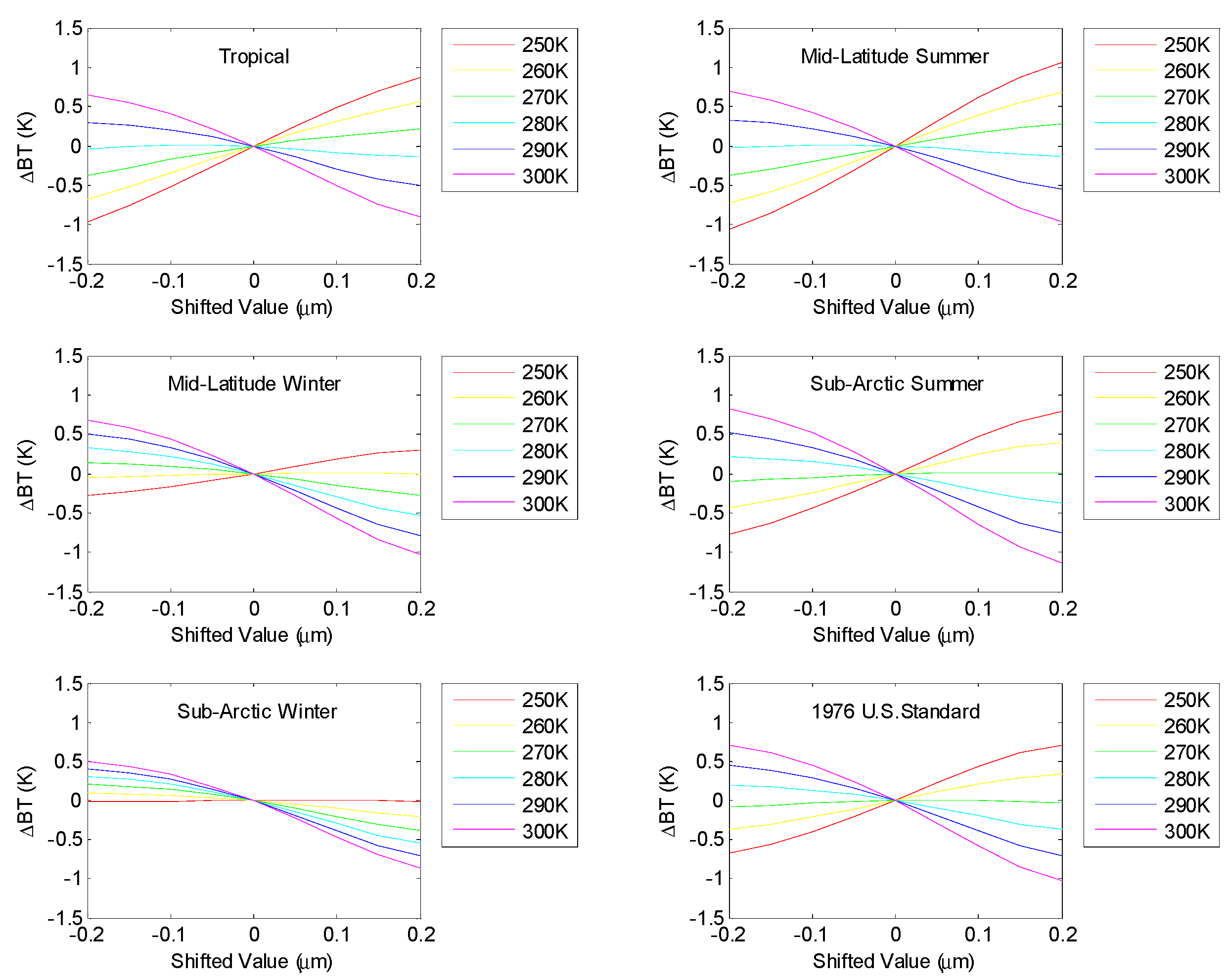
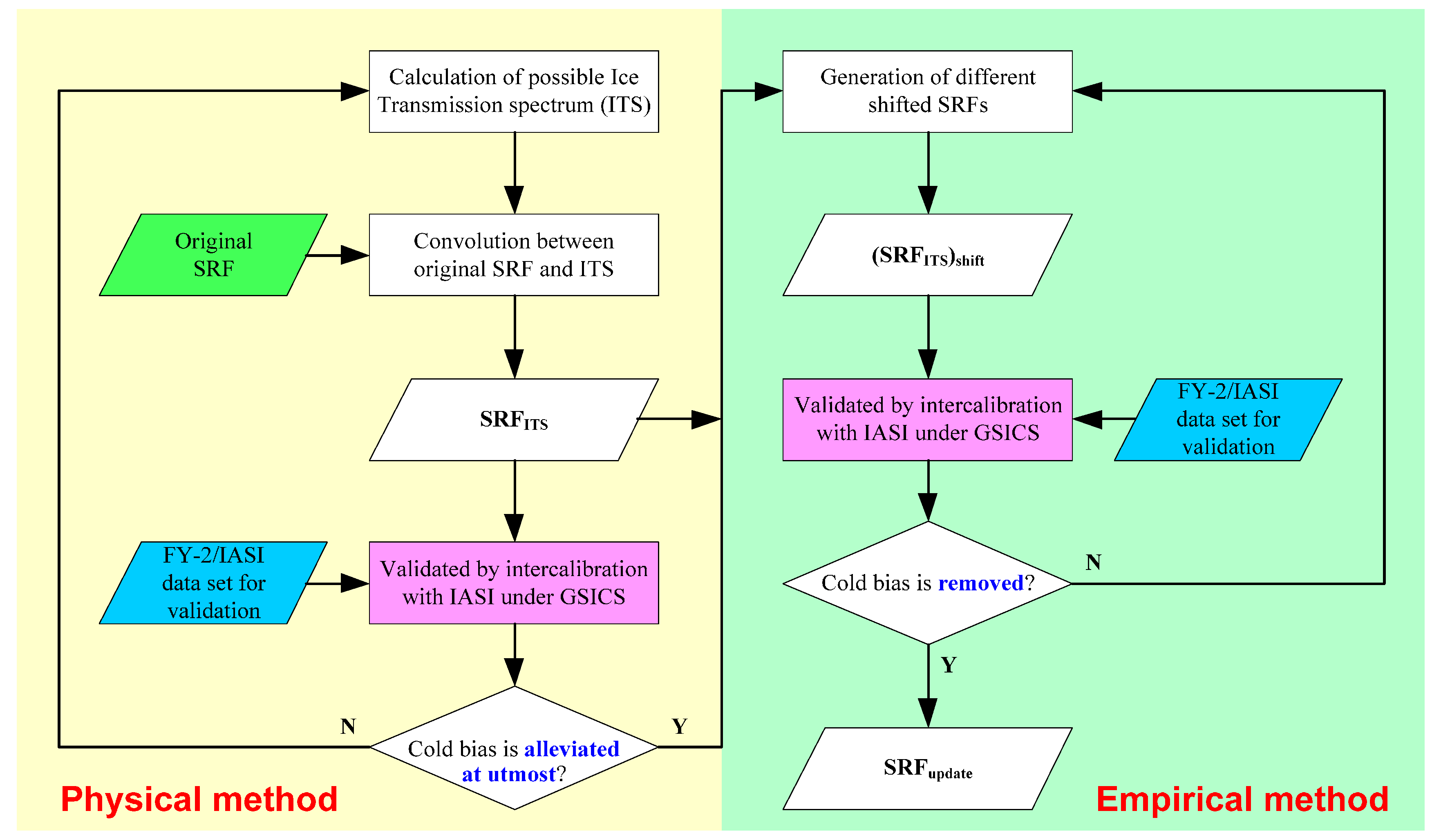




| Time | July 2015 | August 2015 | September 2015 | October 2015 | November 2015 | December 2015 | January 2016 | February 2016 |
|---|---|---|---|---|---|---|---|---|
| Bias(K) | −0.17 | −0.08 | −0.72 | −1.22 | −1.44 | −2.56 | −2.26 | −1.43 |
| STD(K) | 0.42 | 0.82 | 0.61 | 0.45 | 0.42 | 0.70 | 0.87 | 0.54 |
| Samples | 4027 | 3390 | 2378 | 3491 | 3452 | 779 | 3175 | 1444 |
| SRForiginal | SRFITS @Different Ice Layer Thickness (μm) | |||||
|---|---|---|---|---|---|---|
| 1.0 | 2.0 | 3.0 | 4.0 | 5.0 | ||
| Central wavelength (μm) | 11.967 | 11.970 | 11.972 | 11.974 | 11.977 | 11.979 |
| (K)@290 K | −1.05 | −1.04 | −1.03 | −1.02 | −1.01 | −0.99 |
© 2017 by the authors. Licensee MDPI, Basel, Switzerland. This article is an open access article distributed under the terms and conditions of the Creative Commons Attribution (CC BY) license (http://creativecommons.org/licenses/by/4.0/).
Share and Cite
Guo, Q.; Feng, X. In-Orbit Spectral Response Function Correction and Its Impact on Operational Calibration for the Long-Wave Split-Window Infrared Band (12.0 ?m) of FY-2G Satellite. Remote Sens. 2017, 9, 553. https://doi.org/10.3390/rs9060553
Guo Q, Feng X. In-Orbit Spectral Response Function Correction and Its Impact on Operational Calibration for the Long-Wave Split-Window Infrared Band (12.0 ?m) of FY-2G Satellite. Remote Sensing. 2017; 9(6):553. https://doi.org/10.3390/rs9060553
Chicago/Turabian StyleGuo, Qiang, and Xuan Feng. 2017. "In-Orbit Spectral Response Function Correction and Its Impact on Operational Calibration for the Long-Wave Split-Window Infrared Band (12.0 ?m) of FY-2G Satellite" Remote Sensing 9, no. 6: 553. https://doi.org/10.3390/rs9060553
APA StyleGuo, Q., & Feng, X. (2017). In-Orbit Spectral Response Function Correction and Its Impact on Operational Calibration for the Long-Wave Split-Window Infrared Band (12.0 ?m) of FY-2G Satellite. Remote Sensing, 9(6), 553. https://doi.org/10.3390/rs9060553





